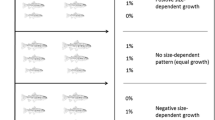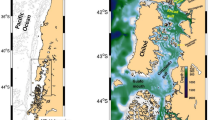Abstract
Variation in size among fishes can have important ecological consequences. The origin and persistence of variation in size among a cohort of juvenile prickly sculpin, Cottus asper, was explored experimentally by manipulating the size variability in juvenile fish and the presence of conspecific adult fishes in a factorial design. I found that adult fish significantly suppressed the growth and survivorship of juveniles, while the variance treatment alone had no effect on growth or survivorship. The presence of adults was also associated with a decrease in size variability in the high variance treatment. An analysis of juvenile growth patterns revealed no evidence for size dependent growth or temporal correlations in growth (`growth autocorrelation'), and are consistent with a lack of amplification of size variance through time. Juvenile C. asper appear to have been feeding on a relatively homogeneous resource and utilizing those resources similarly. Thus, patterns of individual growth and the presence of adult conspecifics may both serve to dampen size differences in this coastal fish species.
Similar content being viewed by others
References cited
Brunkow, P.E. & J.P. Collins. 1996. Effects of individual variation in size on growth and development of larval salamanders. Ecology 77: 1483-1492.
Caswell, H. 2001. Matrix Population Models, 2nd edn., Sinauer Press, Sunderland, MA. 722 pp.
Crowder, L.W., J.A. Rice, T.J. Miller & E.A. Marschall. 1992. Empirical and theoretical approaches to size-based interactions and recruitment variability in fishes. pp. 237-255. In: D.L. DeAngelis & L.J. Gross (ed.) Individual-Based Models and Approaches in Ecology, Chapman and Hall, New York.
DeAngelis, D.L. & C.C. Coutant. 1982. Genesis of bimodal size distributions in species cohorts. Trans. Am. Fish. Soc. 111: 384-388.
DeAngelis, D.L., D.C. Cox & C.C. Coutant. 1979. Cannibalism and size dispersal in young-of-the-year largemouth bass: Experiments and model. Ecol. Model. 24: 21-41.
DeAngelis, D.L., K.A. Rose, L.B. Crowder, E.A. Marschall & D. Lika. 1993. Fish cohort dynamics: Application of complementary modeling approaches. Am. Nat. 142: 604-622.
Elliott, J.M. 1994. Quantitative Ecology and the Brown Trout. Oxford University Press, Oxford. 286 pp.
Forrester, G.E. 1990. Factors influencing the juvenile demography of a coral reef fish. Ecology 71: 1666-1681.
Fraser, D.F., J.F. Gilliam, M.J. Daley, A.N Le & G.T. Skalski. 2001. Explaining leptokurticmovement distributions: Intrapopulation variation in boldness and exploration. Am. Nat. 158: 124-135.
Hare, J.A. & R.K. Cowan. 1997. Size, growth, development, and survival of the planktonic larvae of Pomatomus saltatrix (Pisces: Pomatomidae). Ecology 78: 2415-2461.
Hopper, K.R., P.H. Crowley & D. Kielman. 1996. Density dependence, hatching synchrony, and within-cohort cannibalism in young dragonfly larvae. Ecology 77: 191-200.
Jones, G.P. 1987. Competitive interactions among adults and juveniles in a coral reef fish. Ecology 68: 1534-1547.
Keast, A. & J. Eadie. 1984. Growth in the first summer of life: A comparison of nine co-occurring fish species. Can. J. Zool. 62: 1242-1250.
Kendall, B.E & G.A. Fox. 2002. Variation among individuals and reduced demographic stochasticity. Cons. Biol. 16: 109-116.
Lomnicki, A. 1988. Population Ecology of Individuals. Princeton University Press, Princeton, NJ. 223 pp.
Magnuson, J.J. 1962. An analysis of aggressive behavior, growth, and competition for food and space in Medaka (Oryzias latipes (Pisces, Cyprinodontidae)). Can. J. Zool. 40: 313-363.
Olson, M.H. 1996. Ontogenetic niche shifts in largemouth bass: Variability and consequences for first-year growth. Ecology 77: 179-190.
Osenberg, C.W., E.E. Werner, G.G. Mittelbach & D.J. Hall. 1988. Growth patterns in bluegill (Lepomis macrochirus) and pumpkinseed (L. gibbosus) sunfish: Environmental variation and the importance of ontogenetic niche shifts. Can. J. Fish. Aquat. Sci. 45: 17-26.
Persson, L. 1983. Food consumption and competition between age classes in a perch Perca fluviatilis population in a shallow eutrophic lake. Oikos 40: 197-207.
Persson, L., P. Byström & E. Wahlström. 2000. Cannibalism and competition in Eurasian perch: Population dynamics of an ontogenetic omnivore. Ecology 81: 1058-1071.
Pfister, C.A. 1997. Demographic consequences of within-year variation in recruitment. Mar. Ecol. Prog. Ser. 153: 229-238.
Pfister, C.A. 1999. Recruitment. pp. 181-196. In: M.H. Horn, K.L.M. Martin & M.A. Chotkowski (ed.) Intertidal Fish Ecology, Behavior, and Physiology, Academic Press, New York.
Pfister, C.A. & F.R. Stevens. 2002. The genesis of size variability in plants and animals. Ecology 83: 59-72.
Ricker, W.E. 1958. Handbook of Computations for Biological Statistics of Fish Populations. Fisheries Research Board of Canada, Bulletin no. 119, Ottawa. 300 pp.
Roughgarden, J. 1972. Evolution of niche width. Am. Nat. 106: 683-718.
Rubenstein, D.I. 1981. Individual variation and competition in the Everglades pygmy sunfish. J. Anim. Ecol. 50: 337-350.
Ryer, C.H. & B.L. Olla. 1996. Growth depensation and aggression in laboratory reared coho salmon: The effect food distribution and ration size. J. Fish Biol. 48: 686-694.
Schmitt, J., D.W. Ehrhardt & M. Cheo. 1986. Light-dependent dominance and suppression in experimental radish populations. Ecology 67: 1502-1507.
Smith, C.K. 1990. Effects of variation in body size on intraspecific competition among larval salamanders. Ecology 71: 1777-1788.
Sokal, R.R. & F.J. Rohlf. 1995. Biometry, 3rd edn., New York: W.H. Freeman & Co. 887 pp.
Steele, M.A., G.E. Forrester & G.R. Almany. 1998. Influences of predators and conspecifics on recruitment of a tropical and a temperate reef fish. Mar. Ecol. Prog. Ser. 172: 115-125.
Sweatman, H.P.A. 1985. The influence of adults of some coral reef fish on larval recruitment. Ecol. Monogr. 71: 1666-1681.
Thorpe, J.E. 1977. Bimodal distribution of length of juvenile Atlantic salmon (Salmo salar L.) under artificial rearing conditions. J. Fish. Biol. 11: 175-184.
Uchmanski, J. 1985. Differentiation and frequency distributions of body weights in plants and animals. Phil. Trans. Roy. Soc. London B 310: 1-75.
Uchmanski J. 2000. Individual variability and population regulation: An individual-based model. Oikos 9: 539-548.
Van Valen, L. 1965. Morphological variation and width of ecological niche. Am. Nat. 99: 377-390.
Werner, E.E. & J.F. Gilliam. 1984. The ontogenetic niche and species interactions in size-structured populations. Ann. Rev. Ecol. Syst. 15: 393-425.
Werner, E.E., J.F. Gilliam, D.J. Hall & G.G. Mittelbach. 1983. Experimental tests of the effects of predation risk on habitat use in fish. Ecology 64: 1540-1548.
Wiegmann, D.D., J.R. Baylis & M.H. Hoff. 1997. Male fitness, body size, and timing of reproduction in smallmouth bass, Micropterus dolomieui. Ecology 78: 111-128.
Author information
Authors and Affiliations
Rights and permissions
About this article
Cite this article
Pfister, C.A. Some Consequences of Size Variability in Juvenile Prickly Sculpin, Cottus asper . Environmental Biology of Fishes 66, 383–390 (2003). https://doi.org/10.1023/A:1023903004766
Issue Date:
DOI: https://doi.org/10.1023/A:1023903004766




